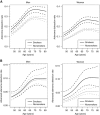Risk factors cannot explain the higher prevalence rates of precancerous colorectal lesions in men
- PMID: 27764840
- PMCID: PMC5129825
- DOI: 10.1038/bjc.2016.324
Risk factors cannot explain the higher prevalence rates of precancerous colorectal lesions in men
Abstract
Background: Prevalence of (pre)cancerous colorectal lesions are higher in men than in women, although transition rates from advanced lesions to cancer is similar in both sexes. Our aim was to investigate whether the sex-specific difference in incidence of premalignant colorectal lesions might be explained by the impact of risk factors.
Methods: A cross-sectional study analysing health check-up examinations and screening colonoscopies performed within a national quality assurance program.
Results: A total of 25 409 patients were included in this study, 50.8% were women. Median age for both sexes was 60 years (interquartile range (IQR) 54-67). A multivariable model showed that risk factors mediated only 0.6 of the 10.4% gender gap in adenoma and 0.47 of the 3.2% gender gap in advanced adenoma detection rate. Smoking was the only independent risk factor with a varying sex-specific effect (men OR 1.46, CI 1.29, 1.64, women OR 1.76, CI 1.53, 2.06) and advanced adenomas (men OR 1.06, CI 0.80-1.42; women OR 2.08, CI 1.52-2.83). Independent risk factors for adenomas were BMI (OR 1.35 per IQR, CI 1.25-1.47) and triglyceride level (OR 1.03 per IQR, CI 1.00-1.06); for advanced adenomas physical activity (none vs regular: OR 1.54, CI 1.18-2.00, occasional vs regular: OR 1.17, CI 1.00-1.38), cholesterol level (OR 1.13 per IQR, CI 1.02-1.25), blood glucose level (OR 1.05 per IQR, CI 1.01-1.09) and alcohol score (OR 1.09 per IQR, CI 1.01-1.18).
Conclusions: Risk factors cannot explain higher prevalence rates in men. Results of this study strongly underline the need for sex-specific screening recommendations.
Conflict of interest statement
Data on screening colonoscopy stem from the ‘Quality certificate for CRC prevention' founded by the Austrian Society for Gastroenterology and Hepatology, the Federation of the Statutory Insurance Institutions and the Austrian Cancer Aid. This study was further supported by the Skoda Award of the Austrian Society of Internal Medicine (to MF).
Figures


References
-
- Anderson JC, Messina CR, Dakhllalah F, Abraham B, Alpern Z, Martin C, Hubbard PM, Grimson R, Shaw RD (2007) Body mass index: a marker for significant colorectal neoplasia in a screening population. J Clin Gastroenterol 41(3): 285–290. - PubMed
-
- Anderson JC, Moezardalan K, Messina CR, Latreille M, Shaw RD (2011) Smoking and the association of advanced colorectal neoplasia in an asymptomatic average risk population: analysis of exposure and anatomical location in men and women. Dig Dis Sci 56(12): 3616–3623. - PubMed
-
- Babor TF, Higgins-Biddle JC, Saunders JB, Monteiro MG (2001) AUDIT. The Alcohol Use Disorders Identification Test. In Guidelines for Use in Primary Care, 2nd edn. World Health Organization: Geneva. Available at http://apps.who.int/iris/bitstream/10665/67205/1/WHO_MSD_MSB_01.6a.pdf.
-
- Bannert C, Reinhart K, Dunkler D, Trauner M, Renner F, Knoflach P, Ferlitsch A, Weiss W, Ferlitsch M (2012) Sedation in screening colonoscopy: impact on quality indicators and complications. Am J Gastroenterol 107(12): 1837–1848. - PubMed
MeSH terms
LinkOut - more resources
Full Text Sources
Other Literature Sources
Medical
Miscellaneous

